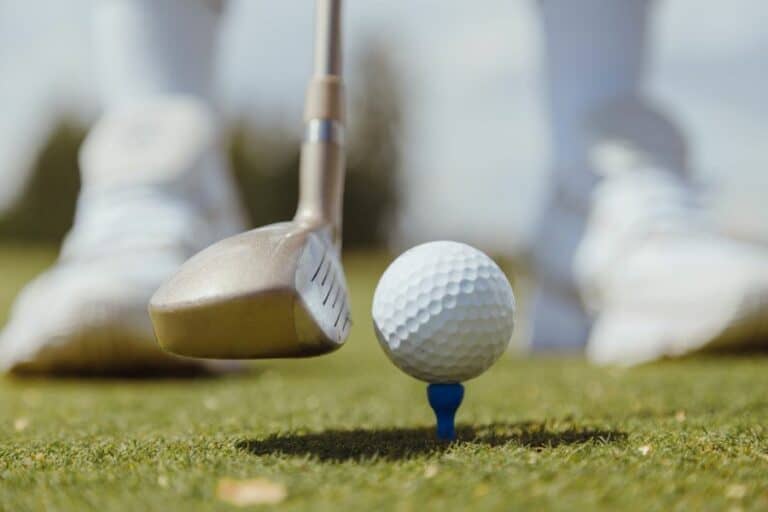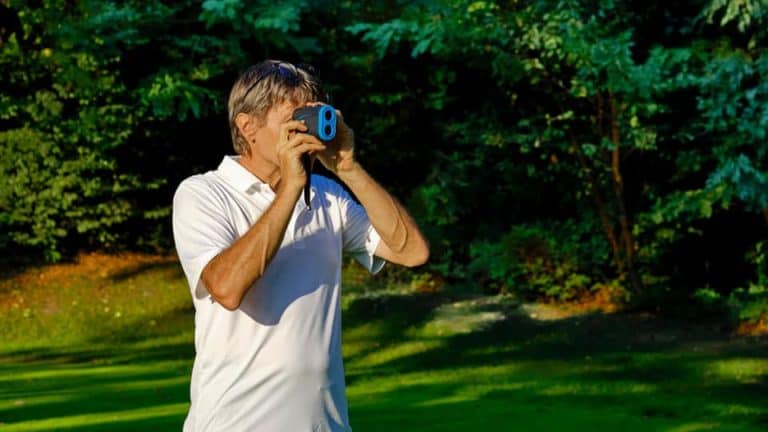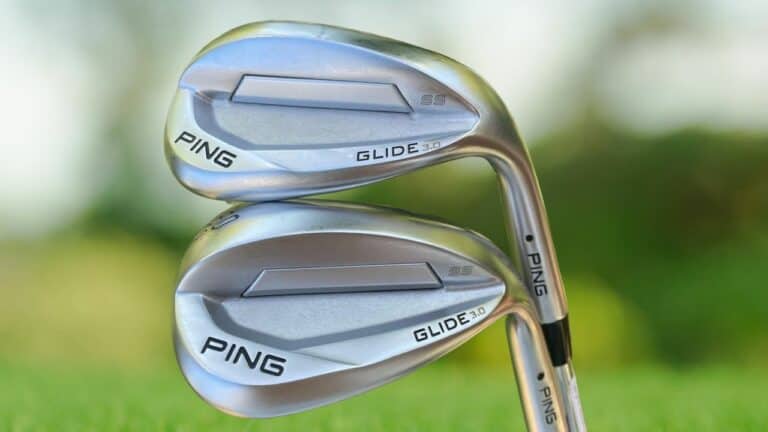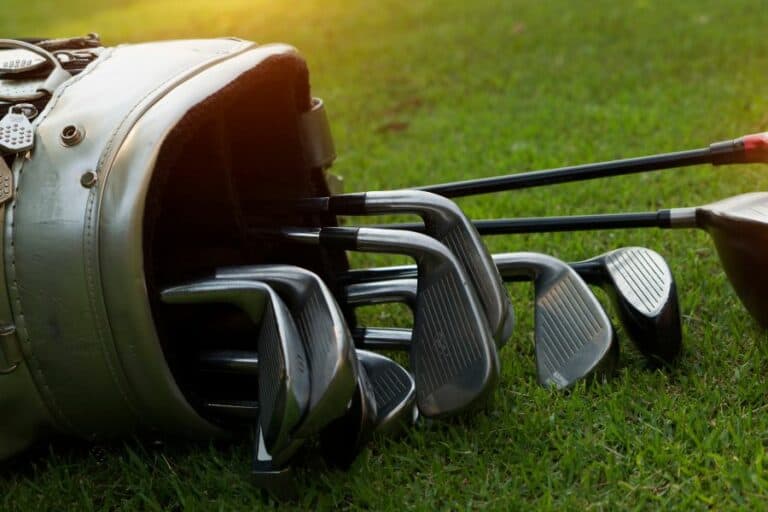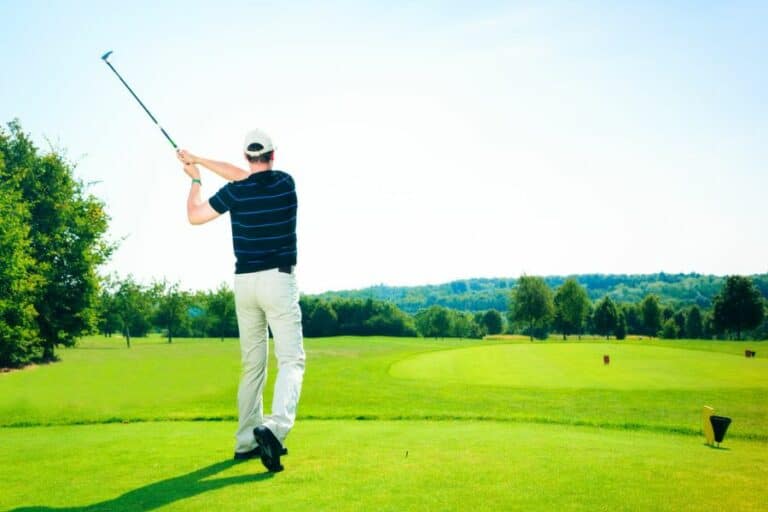How To Put Backspin On A Golf Ball – 3 Things to Consider
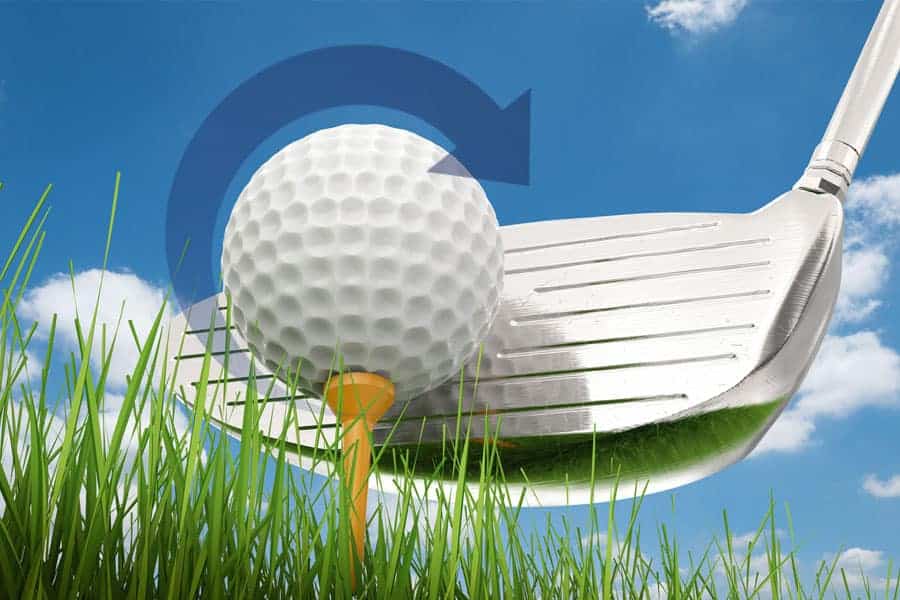
Putting a backspin on a golf ball can provide a strategic advantage in improving your golf game. The most common way of achieving backspin on a golf ball is by using a high-lofted club, like a lob wedge.
Backspin in golf refers to the spin of the ball as it travels through the air. This means the ball rotates backward (towards the player) as it flies through the air. Let’s explore more about putting a backspin on a golf ball.
How to put backspin on a golf ball?
Below mentioned are the steps to follow when trying to put a backspin on a golf ball:
- Position the ball closer to your back foot – This will give you more control over the shot and help you compress the ball into the turf.
- Swing the club with a steep attack angle – This will ensure maximum loft and helps generate enough spin rate on impact.
- Make sure to hit the ball first – That’s where most of your power should come from, as this will compress it into the turf and generate more spin.
- Maintain a high swing speed throughout – Air resistance is important for generating a backspin. So, keep your swing speed fast until impact.
What impacts the backspin on a golf ball?
The three things that help put a backspin on a golf ball are:
- Club head speed
- Spin loft
- Friction
So, when we club it in an equation to create backspin, it would be:
Backspin = Clubhead speed x Spin loft x Friction
1. Clubhead speed
Generating spin on a golf ball essentially boils down to three factors, and one of the key elements is clubhead speed. In other words, the clubhead speed with which the club is swung affects the amount of backspin that is achieved. Generally speaking, a faster swing speed will produce more backspin than a slower swing speed.
Moreover, higher club head speeds typically lead to greater spin rates, like the 80-100 yard wedge shot that generates maximum spin. With chip shots, however, due to their slow speed, this isn’t usually possible, as generating enough power is difficult.
2. Spin Loft
Generating a spin on the golf ball is essential if you want it to roll back toward you after landing. To make this happen, you need to understand Spin Loft – an angle created between the angle of attack and dynamic loft.
- Attack angle
The attack angle is the angle made by the clubhead when it strikes the ball. Your club head needs to follow this line in order for you to make contact with the ball correctly and generate more spin on the shot. Ensuring a higher angle of attack will help improve your spin rate successfully.
- Dynamic Loft
The Dynamic Loft, which is the angle of the clubface at impact, can be greatly impacted by both the club you use and how your shaft is aligned when striking.
The spin loft is the space between the two previously mentioned elements. Generally, when swinging a driver, you would like to decrease its spin loft in order to reduce the ball’s rotation and make it travel further.
However, in this case, we want to increase it as much as possible! Doing so requires a wedge with adequate lift while ensuring your angle of attack remains downward.
3. Friction
Friction affects the backspin on a golf ball by reducing the amount of backspin that the ball has. This is because the friction between the club face and the ball causes the ball to spin and slow down as it leaves the clubface. The amount of backspin is also affected by the loft of the club and the clubhead speed.
Here are four conditions that have a major influence on the friction and, consequently, spin rate:
- To maximize your performance, it is essential to regularly replace the grooves on your wedge. Most professionals change their lob-wedge four times a year or more!
- To achieve maximum spin on the golf course, it’s best to invest in a premium-priced ball, as this will offer superior quality.
- Achieving your best score on the golf course requires a DRY ball, clubface, and turf.
- Minimizing the amount of grass between your ball and clubface is essential for a successful swing. A tightly-packed soil lie or driving range mat can reduce friction, whereas taking a shot from rough terrain will grant you no spin.
If these 4 factors are taken into account, you will likely experience a significant surge in spin-rate.
How is backspin useful?
Backspin can be useful in a number of ways in golf. Firstly, it can help the ball stop quickly when it lands on the green. This is because the backspin on the ball creates friction between the ball and the ground, which can cause the ball to slow down and come to a stop more quickly.
This can be particularly useful when hitting approach shots into the green, as it allows you to control the distance and placement of the golf ball more accurately.
Backspin can also help the ball stay in the air longer and travel a shorter distance, which can be useful when hitting shots over obstacles or trying to control the ball in windy conditions.
Finally, a backspin can help the ball hold its line better in the air and reduce the amount of its sidespin. This can be useful when hitting shots into the green, as it can help the ball stay on its intended line and not veer off course due to sidespin.
Factors that impact the backspin on a golf ball
In order to maximize the amount of backspin that can be achieved, a few factors should be taken into consideration.
1. Club loft
The loft of the golf club being used is one of the main factors in creating a backspin, as higher-lofted clubs will impart more spin on the ball than lower-lofted clubs.
2. Club face angle
The condition of the club face can also have an effect on the amount of backspin generated, as worn or damaged grooves on a golf club can reduce the amount of spin applied to the ball.
3. Grooves
Grooves on a golf club can have a major impact on the spin of the ball. Grooves are the small indentations in the face of the club that allow the ball to grip the club and produce spin. The deeper and sharper the grooves are, the higher the spin generated.
Different types of golf clubs have different grooves designed to generate different levels of spin. For example, a driver has shallow and wide grooves designed to create less spin, while a wedge has deeper and narrower grooves.
4. Swing speed
The swing speed of the golf club plays an important role in determining the amount of backspin the ball will have. The faster the club is swung, the more backspin the ball will have. This is because the club head is striking the ball at a higher speed, which causes the ball to rotate faster as it leaves the clubface.
The backspin helps the ball to stay in the air longer and travel further. A faster swing speed will also typically result in a higher launch angle, increasing the ball’s flight distance.
5. Grass
The grass on a golf course can have a significant effect on the backspin of a golf ball. Grass between the ball and the clubface will cause the ball to spin less.
Drills to improve backspin on golf ball
Improving backspin on a golf ball can help you achieve better control and accuracy on the course. It can also add extra distance to your golf shot, as a ball with a backspin typically has a higher launch angle and stays in the air longer.
Here are some drills to follow on how to get backspin on the golf ball:
- Use a club with a higher loft: The higher the loft on your club, the more spin you will be able to generate on the ball. This is because the loft of the clubface causes the ball to spin more as it lifts off the ground. A lob wedge or sand wedge with a higher loft is a good choice for hitting shots with a backspin.
- Use the right golf ball: Golf balls with a softer cover tend to generate more spin than harder balls. So, if you want to hit a shot with a backspin, try using a ball with a softer cover, such as a two-piece ball or a urethane ball.
- Put the tee in the right place: Place the tee between half an inch and one inch in front of the ball at ground level for a successful shot. Make sure to hit your target by making contact with the ball, then follow through by hitting the tee.
- Make a descending blow: To create a backspin on the ball, you need to make a descending blow through impact. This means the clubhead should descend toward the ground as it interacts with the ball. Set your weight on the front foot and swing slightly to achieve this.
- Use a tighter grip: A tighter grip on the club will encourage a more descending blow-through impact, which can help generate a backspin on the ball. To grip the club tighter, try wrapping your fingers around the club a bit more and applying more pressure with your hands.
- Hit the ball higher on the clubface: Hitting the ball higher on the clubface will help create a higher launch angle and more spin. To do this, try to make contact with the ball closer to the top of the clubface.
With these tips in mind, you should be able to put a backspin on a golf ball and hit some more controlled shots into the green. Practice these techniques on the range and see how they work for you.
Conclusion
To put a backspin on a golf ball, you must ensure that you strike the ball with an upward motion while using a downward motion on the club head. Additionally, you must ensure that the club face is slightly open at impact, and you should also make sure that the club path is slightly from inside to out. This will help to create a lofted shot with a backspin.



